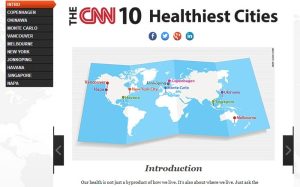LA HABANA ENTRE LAS 10 CIUDADES MÁS SALUDABLES DEL MUNDO: CNN.
La gran cadenas de noticias estadounidense CNN ha ubicado a La Habana, Cuba, entre las 10 ciudades más saludables del mundo. La publicitación reconoce el papel de las autoridades sanitarias de la isla en materia de medicina preventiva.
“Considere estos hechos: Cuba, un país con 11 millones de personas, tiene una esperanza de vida media de 79 años, la misma que la esperanza de vida en los Estados Unidos. La tasa de mortalidad infantil es de hecho mejor que en Estados Unidos. Y el gobierno cubano gasta un promedio de sólo $ 400 por persona en el cuidado de la salud; Estados Unidos gasta cerca de $ 9.000.” dice la publicación de CNN.
“La Habana es un ejemplo de lo que los funcionarios de salud pública en Estados Unidos han estado diciendo durante mucho tiempo: Es mejor prevenir el problema en primer lugar que tener que tratarlo” concluyo CNN.
El gigante de las noticias estadounidense también reconoce como problemas algunos aspectos negativos como los altos niveles de pobreza, el habito de fumar de un gran porcentaje de la población y la imposibilidad de curar enfermedades complicadas o más raras.
Otras ciudades incluidas en la lista son Singapur, Copenhague en Dinamarca, Okinawa en Japón, Monte Carlo en Mónaco, Vancouver en Canadá, Melbourne en Australia y Nueva York en Estados Unidos.
Agencies/InternetPHotos/www.thecubanhistory.com
The Cuban History, Hollywood.
Arnoldo Varona, Editor.
LA HAVANA AMONG TOP 10 HEALTHIEST CITIES OF THE WORLD: CNN. .
It may seem unlikely, but Havana, Cuba, is one of the healthiest cities on the planet.
Yes, much of the country is in abject poverty, and the trade embargo by the United States has kept some of the best medical technologies out of health care workers’ hands. But a focus on prevention has helped many residents avoid the hospital altogether.
Consider these facts: Cuba, a country with 11 million people, has an average life expectancy of 79 years, the same as the life expectancy in the United States. The infant mortality rate is actually better than in America. And the Cuban government spends an average of just $400 per person on health care; the United States spends close to $9,000.
How? One word: prevention.
“Fundamentally, prevention is how you keep your costs down,” says Pierre LaRamee, the executive director of MEDICC, a nonprofit cooperative medical effort between the United States and Cuba. “If you’re a country with very limited resources like Cuba, you put all of your resources into the most effective, most low-cost interventions.”
Simple things like a near-100% vaccination rate and regular health screenings help. Every community has a network of small doctors’ offices in nearby homes and free access to neighborhood “polyclinics.”
Larger tertiary care hospitals are reserved for the most complicated cases, and problems that can be headed off early in the small clinics are dealt with locally.
Taking care of yourself and your neighbors is a practice that everyone is taught from a young age in Havana, says LaRamee. Kids are taught basic first aid and CPR, which is important in an area that’s often in the path of many hurricanes and where emergency medical services are scarce.
“If people are trained early on to think about their overall health – the need for proper nutrition, the need for exercise – that creates a culture of health,” LaRamee says.
Another effect of the government’s focus on preventive care: Medical school is free, and Cuba trains more doctors than any other Latin American country.
Some critics point out that doctors make between $20 and $30 per month, about the same as everyone else, and are often forced to take side jobs as taxi drivers to earn extra money. Treatment for more complicated or rare diseases is often nonexistent and 25% of the adult male population still smokes.
All of that said, Havana is a prime example of what public health officials in America have been saying for a long time: It’s better to prevent the problem in the first place than to have to treat it.
Agencies /CNN/ Matt Sloane, CNN/InternetPhotos /thecubanhistory.com
The Cuban History, Hollywood.
Arnoldo Varona, Editor



 LA HAVANA among top 10 healthiest cities of the world: CNN. ** LA HABANA entre las 10 ciudades más saludables del mundo: CNN.
LA HAVANA among top 10 healthiest cities of the world: CNN. ** LA HABANA entre las 10 ciudades más saludables del mundo: CNN.

